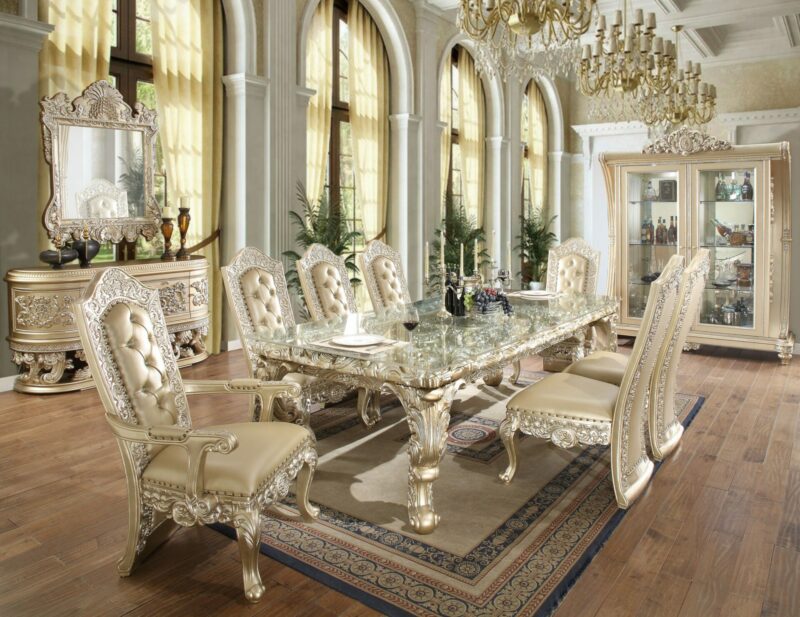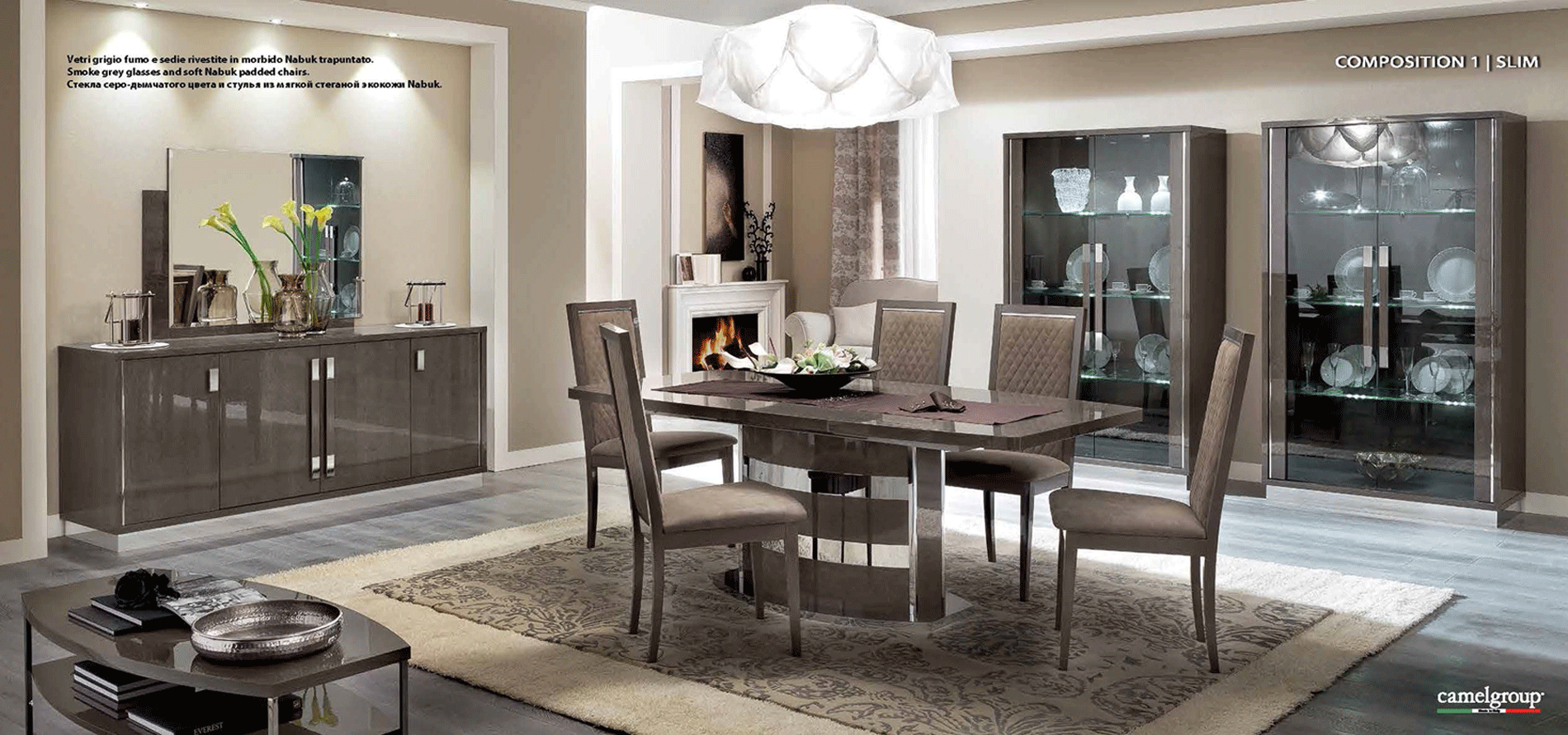Blog
How to Maintain Your Dining Room Set

A Dining Room Set is a true showpiece—a symbol of hospitality, family connection, and personal style. Whether your set features a grand dining table with two captain’s chairs and eight side chairs, or a bench and a buffet to complete the collection, it’s likely a central element in your home. With its size and function, this furniture sees frequent use and must endure everything from family dinners to holiday parties.
But such a large and valuable set comes with an equally large responsibility: maintenance.
In this comprehensive guide, we’ll show you how to properly clean, protect, and preserve your dining room set so it stays stunning and structurally sound for many years. With a little knowledge and consistency, your dining space can remain as beautiful and inviting as the day you bought it.
1. Know Your Materials: The Foundation of Proper Care
To maintain your dining set effectively, you need to understand what it’s made of. Different materials demand different maintenance routines.
Common Materials:
- Solid Wood (Oak, Mahogany, Walnut, Pine): Classic and durable, but sensitive to heat, moisture, and scratches.
- Engineered Wood (MDF, Veneer): Budget-friendly and stylish, but more vulnerable to water damage.
- Glass: Sleek and modern, but shows fingerprints and scratches easily.
- Metal (Iron, Aluminum, Brass): Adds a contemporary touch, but may rust or tarnish over time.
- Upholstery (Fabric, Velvet, Leather): Adds comfort and design, but is prone to staining and fading.
Knowing the materials used in your set allows you to choose the right cleaning agents and avoid damage.
2. Clean Your Dining Room Set Regularly
Daily Cleaning Tips
- Wipe Down Surfaces: Use a soft, damp microfiber cloth to remove dust and food crumbs from the table and chairs.
- Avoid Harsh Chemicals: Stick to mild soap or cleaners recommended for the material of your dining set. Harsh chemicals can damage finishes or upholstery.
Deep Cleaning Routine
- Weekly Dusting: Use a dry microfiber cloth to prevent dust buildup, especially on wood and intricate chair designs.
- Monthly Polishing: If your dining table is wooden, polish it once a month with a suitable wood polish to keep the finish glossy and protected.
Read more: How to choose living room furniture
3. Protect the Surface of Your Dining Table
Use Tablecloths and Placemats
Prevent Scratches and Heat Damage: Always use placemats, table runners, or coasters under hot dishes and beverages.
Add a Decorative Layer: Besides protection, tablecloths and runners enhance your dining room aesthetics.
Avoid Direct Sunlight
Prevent Fading: Continuous sunlight exposure can fade wood and fabric. Position the dining set away from windows or use curtains/blinds to protect it.
4. Take Care of Upholstered Dining Chairs
- Vacuum Regularly: Dust and crumbs can settle into the fabric. Use a vacuum with a soft brush attachment to keep it clean.
- Spot Clean Spills Quickly: Blot spills with a clean, dry cloth immediately to prevent stains.
- Consider Fabric Protection: Applying a fabric protector can make your chairs more resistant to stains and moisture.
5. Maintain Wood, Glass, and Marble Surfaces
Wood Dining Sets
- Keep away from moisture and heat sources.
- Apply furniture oil or wax every 6–12 months to maintain the finish.
Glass Dining Tables
- Use a glass cleaner for a streak-free shine.
- Avoid placing heavy objects that can cause cracks or chips.
Marble Dining Tables
- Clean with a damp cloth and pH-neutral cleaner.
- Seal the marble surface periodically to prevent staining and etching.
Also Check: Dining Room Sets for 8
6. Daily and Weekly Cleaning Routines
Regular upkeep is the easiest way to prevent long-term damage.
Daily:
- Wipe Down After Meals: Use a soft cloth slightly dampened with water to remove crumbs, spills, or smudges.
- Check for Spills: Food or drink left unattended can stain or damage surfaces quickly.
Weekly:
- Dust All Surfaces: A microfiber cloth is perfect for removing dust without scratching.
- Vacuum Upholstered Chairs: Use the brush attachment to lift dirt and crumbs from seat cushions and seams.
- Clean Glass Surfaces: Use a non-abrasive cleaner and a lint-free cloth for a streak-free finish.
- Clean Metal Frames or Accents: Wipe with a damp cloth and dry thoroughly to prevent corrosion.

How to Maintain Dining Room Set
7. Monthly Maintenance Checklist
Once a month, set aside time to go beyond the basics.
- Polish Wood Surfaces: Use a high-quality furniture polish or natural oil (like lemon oil) to maintain the finish and protect against drying or cracking.
- Tighten Screws and Bolts: Tables and chairs tend to loosen with frequent use. Secure all joints to avoid wobbly or creaky furniture.
- Inspect Table Leaves and Mechanisms: If your table expands, check the sliding mechanism for dust buildup. Clean and lubricate if needed.
- Freshen Upholstery: Sprinkle baking soda on fabric seats, let sit for 15 minutes, then vacuum to neutralize odors.
8. Seasonal Deep Cleaning and Adjustments
As the seasons change, so do humidity levels and lighting conditions—both of which can affect your dining furniture.
Every 3 to 4 Months:
- Condition Wood Surfaces: Especially important in dry or fluctuating climates. Conditioning prevents cracking, warping, and finish loss.
- Clean Leather Upholstery: Use a leather-safe cleaner followed by conditioner to keep it soft and supple.
- Shampoo Fabric Chairs: Use an upholstery cleaner or rent a steam cleaner for deep cleansing.
- Wash or Replace Covers and Runners: Launder placemats, chair covers, and table runners to refresh your décor and hygiene.
- Check for Sunlight Exposure: If sunlight hits certain chairs or the table consistently, rotate them or use UV-filtering curtains to prevent fading.
Also Check: Dining Room Sets for 6
9. Preventing Common Damage
The best way to maintain your dining set is by preventing problems before they start.
Heat and Water:
- Always use coasters under hot or cold drinks.
- Set down hot plates or serving dishes on trivets or placemats—not directly on wood or glass surfaces.
Scratches:
- Use placemats or tablecloths for everyday meals to prevent scuffs and scratches.
- For chairs, apply felt pads to the legs to avoid scraping the floor and keep chairs level.
Stains:
- Blot spills immediately—never rub.
- Use stain repellents on fabric or leather (test first).
- Keep ink pens and markers away from upholstery—especially in homes with kids.
Pets:
- If you have cats or dogs, chair slipcovers and scratch guards can help preserve upholstery and legs.
- Keep nails trimmed to avoid accidental damage when pets jump up.
Also Check: Dining Room Sets for 4
10. Long-Term Preservation and Structural Care
Your dining room set will last decades if you take structural maintenance seriously.
Avoid Dragging
- When rearranging your dining area, always lift tables and chairs. Dragging stresses joints and can crack wood or damage floors.
Reinforce Weak Points
- Over time, screws can loosen and joints may weaken. Use wood glue or have a professional rejoin the structure if needed.
Store Unused Pieces Safely
If you only use some chairs occasionally or have a leaf insert for your table:
- Store them in a climate-controlled space.
- Cover with breathable fabric (not plastic) to avoid trapping moisture.
- Keep them off the ground to prevent leg warping.
11. Protecting Your Dining Room Set from Everyday Hazards
Your dining set is constantly exposed to potential hazards, such as stains, scratches, and heat. However, there are effective ways to protect it before these issues cause significant damage.
Protection from Heat:
- Use Trivets and Hot Pads: Never place hot dishes or cups directly onto the table or wooden surfaces. Always use trivets or hot pads to protect the surface from heat damage.
- Extreme Temperatures: Avoid exposing your table to direct sunlight or any heat sources for prolonged periods. High temperatures can cause wood to warp or surfaces to become discolored.
Protection from Stains:
- Use Protective Covers: Always set down placemats or tablecloths to prevent stains from food and drinks.
- Address Spills Immediately: Don’t wait for stains to set in. Quickly blot any liquids or food using a clean, dry cloth to prevent absorption into the surface.
- Apply Surface Protectors: Use surface protectors like plastic or silicone mats on wooden chairs or tables to prevent scratches and damage.
Protection from Scratches:
- Use Felt Pads on Chair Legs: Attach felt pads to the bottom of chair legs to prevent them from scratching the floor when moved.
- Be Cautious When Moving Furniture: Always lift chairs and tables rather than dragging them to avoid damage to the legs or surface.
Also Check: 11 Piece Dining Room Sets
12. Creating a Functional and Stylish Setup
Maintenance isn’t just about cleaning—it’s about making your dining room a welcoming and practical space.
Rotate Décor:
- Update your centerpiece with flowers, candles, or seasonal items to keep the space lively.
- Swap placemats and runners regularly to refresh the look.
Manage Traffic Flow:
- Don’t overcrowd the room. Make sure chairs can be pulled out easily and guests can walk around comfortably.
- Use a rug to define the space and protect floors from chair movement.
Lighting:
- Install a dimmer for your overhead light to create ambiance.
- Clean light fixtures regularly to keep the space looking bright and polished.
13. When to Consider Professional Help
If your dining set is antique, custom-made, or very expensive, don’t hesitate to bring in professionals for:
- Reupholstery Services: Great for refreshing or upgrading worn-out chairs.
- Wood Refinishing: If your table has deep scratches or the finish is worn.
- Deep Cleaning: Especially for tough stains or delicate fabrics.
Professional care extends your set’s life significantly—and often costs much less than replacing it.

Dining Room Set
14. Bonus: Maintenance Schedule Summary
Here’s a simple maintenance schedule to keep your set in peak condition:
Daily
- Wipe spills and food.
- Light dusting.
Weekly
- Vacuum cushions.
- Clean surfaces (wood, glass, metal).
Monthly
- Tighten joints.
- Polish wood.
- Deodorize upholstery.
Seasonally
- Deep clean fabric or leather.
- Condition wood and leather.
- Inspect for fading, rust, or warping.
- Update decor and layout.
Print this out and keep it in a drawer—it’s a helpful reminder!
Final Thoughts
A well-made, well-maintained dining room set isn’t just furniture—it’s the backdrop of birthdays, anniversaries, game nights, and holiday gatherings. With consistent care and a little preventive effort, it can last not only through your lifetime but also be passed down to future generations.
Make maintenance a part of your home care routine, and your dining room will remain a source of pride, comfort, and countless memories for years to come.

